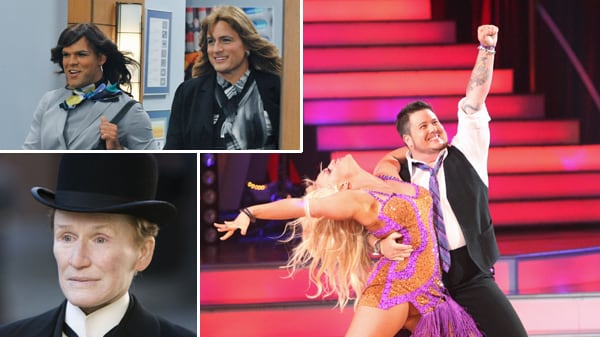There is a scene in Albert Nobbs, the movie starring Glenn Close as a woman who passes as a man to survive in late-19th-century Dublin, in which Albert Nobbs and Hubert Page, another woman living as a man, played by Janet McTeer, take a stroll on the beach wearing dresses.
They’ve been living for so long as men that wearing women’s clothing is as much drag to them as it would be if their male counterparts were donning lace frocks. They stagger awkwardly, inelegantly walking like bowlegged cowboys, before Nobbs suddenly breaks stride and begins running through the wind. After a moment of feeling freedom, Nobbs trips and falls. Soon, the gentle butler is back in his usual garb, a suit and tie covering a constrictive corset that hides his breasts.
To call the two characters transgender would be anachronistic. Indeed, in the original short story that the movie is based on, author George Moore had created a term for Albert: “perhapser.” “It’s very foolish of an old perhapser like me, neither man nor woman!” thinks Albert. “But I can’t help it.” Transgender in the modern sense is what Leslie Feinberg applied to gender warriors of all kinds in the 1998 treatise, Trans Liberation, writing: “We are a movement of masculine females and feminine males, cross-dressers, transsexual men and women, intersexuals born on the anatomical sweep between female and male, gender-benders, many other sex and gender-variant people, and our significant others.”

Albert and Hubert didn’t set out to be gender warriors; they lived as men to survive. But the interpretation today of their story taking place more than a century ago brings visibility to film audiences—right in time for Academy Award consideration. Both Close and her co-star Janet McTeer have been nominated for numerous awards in the Best Actress and Best Supporting Actress categories (including for the Golden Globes and the Screen Actors Guild Awards).
Are we having a trans moment? Until recently, transgender issues were nearly invisible in the mainstream press—but now, everywhere you turn, transgender stories are being told. From Andrej Pejic and Lea T, two trans models currently walking the high-fashion runways, to the outrage over Work It, the hapless, now-canceled ABC comedy featuring two men who resort to drag to get a job, transgender awareness is growing exponentially by the moment—seeping into pop culture in films like Albert Nobbs.
Take a glimpse at your TV screen, movie theater, and your iPad and you might agree. In a recent Saturday Night Live skit, host Ben Stiller played a male passenger on an airplane. Suddenly he leans over across the woman in the middle seat and asks the unseen person sitting in the window seat, “Don’t I know you?” The camera pans to Stiller, dressed as a woman, as the words, “Get To Know Your Future Self,” flash on the screen.
From Pedro Almodovar’s twisted medical noir, The Skin I Live In, to Nobbs, to the recent French film, Tomboy, which features a Nobbsian character, a young girl who passes for a boy, to Justin V. Bond’s coming out as a transperson in New York magazine, with a record and book tour, it seems like trans might be the new gay in pop culture. As articles appear in The New York Times about transmale fashion zines like Original Plumbing, and as trans supermodels walk the runways, it’s becoming clear that we are entering a new world.
Even the Girl Scouts have entered the fray. When a trans child was denied admittance into a Girl Scouts troop in Colorado, the child’s parents appealed and the Girl Scout relented. But that decision wasn’t pleasing to everyone: A Girl Scout, known only as Taylor from Ventura County, Calif., called for a boycott over the organization’s open-mindedness, resulting in countercalls from trans supporters vowing to buy even more cookies. And more important, last month, a federal-court ruling in favor of Vandiver Elizabeth Glenn, who was fired from her job after coming out as transgender, led Time magazine to declare transgender people’s legal issues to be the next big civil-rights frontier.
Chaz Bono is the first bona fide transgender celebrity. When Bono was first cast to be on last fall’s Dancing With the Stars, the outrage was palpable. But within a few weeks of Bono’s appearance on the show, he’d quickly turned from pariah to underdog—the person Americans probably least expected to like, but rooted for the most.
The question is why is this shift happening now?
“People have gotten pretty comfortable with gays and lesbians,” said Bono. “I think this is the next issue.”
Or, if you believe Susan Stryker, a trans activist, historian, and scholar, who herself transitioned in the early ‘90s, we are in the midst of a longer cycle—one that began in the ‘90s but has been repeating itself throughout history.
“Every few decades there seems to be a big moment. I think we’re in one of those moments now.” When Bono and Thomas Beattie, the “pregnant man,” made the news, Stryker said she thought, “Oh, here we go again.”
“I study this stuff. So, I see lots of parallels between what is happening with Chaz Bono now and what happened with Renee Richards in the ‘70s and with Christine Jorgensen in the ‘50s, and this person named Zdenk Kubkov, who you’ve never heard of, in the 1930s. There’s a kind of fascination with transgender stuff that recurs from time to time. Every few decades there seems to be a big moment. I think were in one of those moments now.”
But this time, it’s different—in part because the Internet and social media have helped spread the fascination further than a single episode of Sally Jesse Raphael or a single trans person like Richards. That fascination is seeping into our culture, and is now translating into greater strides for the transgender civil-rights movement. Every day news stories pop up about transgender rights being trampled on, like this one about a woman in the early stages of female-to-male transition allegedly being fired because she wore a fake penis under her clothes at work.
In art, it’s hard to pass over the seductive aspects of a transgender character. The duality and ambiguity of trans identities gives friction and intrigue to Albert Nobbs, Tomboy, and The Skin I Live In, and will surely continue to be a wellspring of inspiration.
In Tomboy, a French movie released last fall, the main character is an androgynous girl who purposely passes as a boy. She does so intentionally—even going so far as to build a fake penis out Play-Doh to put in her swimming briefs (which had been cut from her girl’s one-piece bathing suit).
“It’s really a good premise for fiction,” says Céline Sciamma, the film’s writer and director. “Because it’s about the lives, about the double identity, it’s about the confusion, it’s about the confused desire that such character can trigger,” she said. “It’s like a myth, it’s like a new way to speak about mythology in a modern way because they are modern characters.”
Tomboy raises the question of whether or not the girl is a tomboy in the classic sense of the word—a sporty girl who likes playing more with boys and their toys than with other little girls and their dolls—or whether she, at some point in the future, would consider herself “trans.”
“The movie doesn’t tell—all the hypothesis are true, actually,” says Sciamma. “One could say she is a genderless child, but one could also say it’s like you know how they say it: ‘just like a phase.’ I have my own opinion about how she is going to grow old, but, I mean, the movie doesn’t have one…. I think it’s part of the success of the movie, actually, that everybody can relate and have their own conclusion.”
But the very fact that we are applying the word trans to a tomboy is a new development and one that is indicative of the movement at large.
If trans visibility is bigger than ever, a large part of that is because of Bono. In a way, Bono is the perfect person for the current trans moment—a product of our celebrity and media culture, outed as a lesbian by the National Enquirer in 1990, whom we’ve watched grow and change since he was a (female) child.
“With Chaz,” said Stryker, “you see something about the whole celebrity media and tabloid culture kicking into gear. He has been well primed to become the focal point for these larger cultural concerns about what makes a person and the kind of world that we live in.” She continued, “This time it’s at a different scale than it was last time.”
The son of Sonny and Cher, Bono is comfortable being on camera—since he’s been on a stage for his entire life—and can clearly and succinctly explain complex ideas like the difference between gender and sex, and gender and sexuality, to someone like David Letterman, who, like many Americans, is open-minded, but was clearly baffled when Bono appeared on the Late Show last May. In a way, the fact that Bono is someone who is so familiar to many Americans helps them grasp the concept of changing genders and erasing that stain of Jerry Springer shows of years’ past.
“I know why the right wing was afraid when he went on Dancing With the Stars,” said Bono’s publicist Howard Bragman. “It was simple. It was that he would be a normal, likable guy. Their biggest fear has been realized.” He noted, wryly, “Ironically, no one said word one about Carson Kressley—openly gay.”
Buck Angel, the world’s only male porn star with a vagina, who first came out as trans in 2003, says that much has changed since he first arrived on the scene. “Well, when I first started doing my stuff, specifically in the adult world, it was not heard of,” he said. “But then, people just didn’t know people like me existed. It was like I was a Martian or something. Like an alien.”
While it has been 15 years and counting since Ellen DeGeneres came out the cover of Time, helping people start to come around to concepts like gay marriage and gays in the military, trans awareness has grown exponentially, through the Internet’s connectedness.
“The gay movement started officially in ‘69, and we didn’t have the access to media and social media and the speed of things didn’t travel as quickly as they do now,” said Bono. He recalls his own experience of being outed by the National Enquirer. “Then, it was a slow drip of information,” he said.
“But when I came out and said I was transitioning, it went out, that morning. And by that night I was on CNN and it was crazy. Everything happens instantly now,” he said. “It’s amazing.”
Stryker points out that the burgeoning trans movement of the 1990s got a huge helping hand when the Internet came to the mainstream. “Netscape made the first web browser in 1994 ... It’s like, that just took off like a rocket. It changed the way people organized, it changed the level of and the amount of information that was circulating, the level of visibility and awareness of speed which knowledge was transmitted.”
As the trans movement permeates pop culture, we can imagine there will be more movies like Albert Nobbs, which is telling both an old story and a new one. Back then, they didn’t have all the newfangled terminology, they wouldn’t have known the difference between a transwoman, or a butch dyke, or a boi. Nobbs would be hard-pressed to understand his gender identity as something that would be trending in popular culture.
Or, as Hubert says toward the end of the film, “Albert, you can be whoever you are.”






